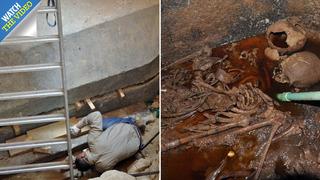Mystery 9-foot black sarcophagus in Egypt OPENED – despite warnings over ancient curse
Officials say the spooky relic isn't cursed – but the deadly history of Egyptian archaeology has left onlookers worried

Officials say the spooky relic isn't cursed – but the deadly history of Egyptian archaeology has left onlookers worried

ARCHAEOLOGISTS in Egypt have opened an eerie 2,000-year-old sarcophagus hidden inside a buried tomb, revealing its mysteries – DESPITE fears of an ancient curse.
Defiant scientists broke open the sinister stone coffin on Thursday and discovered three decomposed mummies submerged in rancid sewer water.
Measuring nine-foot long, the 2,000-year-old black granite coffin – unearthed by archaeologists and researchers – is the largest ever to have been discovered in the ancient Egyptian city of Alexandria.
The coffin's discovery at the beginning of July caused a stir in the archaeology community after worried onlookers warned over an ancient curse.
King Tutankhamun's tomb opening in 1922 was followed by a string of deaths of people involved with the discovery.
Archaeologists, and even their family members, died from horrible illnesses or in strange accidents – and some say the deaths weren't a coincidence.
But Mostafa Waziri, Secretary-General of Egypt's Supreme Council of Antiquities, poured cold water on curse chatter surrounding the latest Egyptian discovery.
"The sarcophagus has been opened, but we have not been hit by a curse," Waziri proclaimed.
He added that none of the three mummies belong to a Ptolemaic or Roman royal family, as had previously been suggested.
Waziri also pointed out that no silver or gold metallic masks, small statues, amulets or inscriptions were found inside the stone coffin, further backing up the claim that these remains aren't those of royals.
Shaban Abd Monem, a specialist in mummies at the Ministry of Antiquities (MOA), : “Preliminary examination suggests the skeletons belong to three army officers, one of them his skull shows an injury of an arrow".
The skeletons and the coffin will now be moved to Alexandria's National Restoration Museum where the remains will be examined to identify the cause of death and historical era, the MOA said in a statement.
On Wednesday, the MOA confirmed that it would open the relic, according to the Egypt Independent.
Tutankhamun's tomb was opened on November 29, 1922. These are the deaths that followed...
The Ministry said it planned to use thick pipes to raise the sarcophagus' lid until archaeologists could see inside.
Experts say the sarcophagus is built from black granite and is covered in a thick layer of mortar, which indicates it's never previously been opened.
Dr. Ayman Ashmawy, head of the Ancient Egyptian Antiquities Sector, said the tomb was found at a depth of 5meters beneath the ground.
The relic measures nine feet long, five feet wide, and six feet tall.
Scientists who helped excavate the site still aren't sure why it's so big, because Ancient Egyptians were typically much smaller than modern men – and nowhere near nine feet.
The average height of an Ancient Egyptian man was just over five foot, while women were typically just shy of five foot.
But there's more to this baffling discovery than just the sarcophagus.
The tomb where it was found also also contained an alabaster head of an unknown man, which Egypt's Ministry of Antiquities suggested belonged to the person inside the relic.
Another theory floating about is that the large size of the coffin indicates it belonged to a powerful or wealthy person such as Alexander the Great, who founded his namesake city of Alexandria in 331 B.C.
The Macedonian warrior died just eight years later in the same region, but his final resting place has never been found.
Here's what you need to know...
Opening ancient tombs can be risky business, or so history tells us.
It's popular belief that a "curse of the pharaohs" is cast on anyone who disturbs the mummy of an Ancient Egyptian person.
This alleged curse is said to affect anyone: not only thieves, but scientists and archaeologists too.
It was popularised by the 1922 opening of the tomb of Tutankhamun, which seemingly led to a string of deaths of people associated with the discovery.
The most notable passing was of Lord Carnarvon, the British financial backer of the excavation team who was present at the tomb's opening.
He died four months after the tomb was opened due to an infected mosquito bite.
Another Brit called Howard Carter, who helped open the tomb, also died – albeit more than a decade later. Still, some attribute his death to the pharaoh's curse.
Historians say there were 11 related deaths within the first 10 years of Tutankhamun's tomb opening.
But the curse hasn't come true, says Egypt's Supreme Council of Antiquities – well, at least not yet.
We pay for your stories! Do you have a story for The Sun Online news team? Email us at tips@the-sun.co.uk or call 0207 782 4368 . We pay for videos too. Click here to upload yours.

777 BDT IPL 2025 Sports First Deposit Bonus



